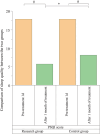Efficacy and exploratory analysis of potential mechanisms of stellate ganglion block in alleviating sleep disturbance in generalized anxiety disorder: a randomized controlled trial excluding comorbid depression
- PMID: 40401023
- PMCID: PMC12092344
- DOI: 10.3389/fneur.2025.1554841
Efficacy and exploratory analysis of potential mechanisms of stellate ganglion block in alleviating sleep disturbance in generalized anxiety disorder: a randomized controlled trial excluding comorbid depression
Abstract
Objective: To investigate the efficacy and mechanisms of stellate ganglion block (SGB) in treating generalized anxiety disorder (GAD) with sleep disturbance, excluding patients with comorbid depression.
Methods: This double-blind randomized controlled trial (RCT) enrolled 128 patients with GAD (Hamilton Anxiety Scale [HAMA] > 14, Generalized Anxiety Disorder 7-item Scale [GAD-7] ≥ 5) and sleep disturbance (Pittsburgh Sleep Quality Index [PSQI] ≥ 15), randomized to receive SGB (n = 64, 4 ultrasound-guided 1% lidocaine injections) or conventional treatment (n = 64, cognitive behavioral therapy [CBT] + estazolam 1-2 mg/day). Outcomes included anxiety (HAMA), depression (Hamilton Depression Scale [HAMD]), sleep quality (PSQI), polysomnography (PSG), and neurotransmitter levels (norepinephrine [NE], serotonin [5-HT], neuropeptide Y [NPY]).
Results: After 4 weeks, SGB demonstrated higher efficacy (98.4% vs. 89.1%, p = 0.028) and greater reductions in HAMA (9.36 ± 2.34 vs. 11.87 ± 2.71, p < 0.001) and HAMD scores (6.87 ± 2.01 vs. 8.09 ± 2.04, p < 0.001). PSQI improved significantly in the SGB group (5.74 ± 1.64 vs. 8.03 ± 1.86, p < 0.001), with increased total sleep time (TST) (429.76 ± 33.22 vs. 391.13 ± 30.76 min, p < 0.001) and efficiency (90.23 ± 13.29% vs. 86.34 ± 12.84%, p < 0.001). Neurotransmitter analysis showed reduced NE (289.43 ± 51.68 vs. 253.78 ± 57.12 pg./mL, p < 0.05) and increased 5-HT (138.56 ± 19.73 vs. 124.93 ± 18.44 ng/mL, p < 0.05) and NPY (453.21 ± 73.41 vs. 402.34 ± 68.12 pg./mL, p < 0.05). Adverse events were comparable (6.25% vs. 3.13%, p = 0.403).
Conclusion: SGB effectively improves GAD symptoms and sleep quality in patients without comorbid depression, potentially via modulation of NE, 5-HT, and NPY pathways. The exclusion of psychiatric comorbidities enhances the specificity of these findings.
Keywords: efficacy; generalized anxiety disorder; mechanism; sleep disturbance; stellate ganglion block.
Copyright © 2025 Liu, Ma, Zhou, Yang, Wang and Wang.
Conflict of interest statement
The authors declare that the research was conducted in the absence of any commercial or financial relationships that could be construed as a potential conflict of interest.
Figures


Similar articles
-
[Ultrasound-guided stellate ganglion block improves sleep quality in elderly patients early after thoracoscopic surgery for lung cancer: a randomized controlled study].Nan Fang Yi Ke Da Xue Xue Bao. 2022 Dec 20;42(12):1807-1814. doi: 10.12122/j.issn.1673-4254.2022.12.08. Nan Fang Yi Ke Da Xue Xue Bao. 2022. PMID: 36651248 Free PMC article. Clinical Trial. Chinese.
-
Clinical Efficacy of the Chinese Herbal Medicine Shumian Capsule for Insomnia: A Randomized, Double-Blind, Placebo-Controlled Trial.Neuropsychiatr Dis Treat. 2022 Mar 29;18:669-679. doi: 10.2147/NDT.S349427. eCollection 2022. Neuropsychiatr Dis Treat. 2022. PMID: 35378821 Free PMC article.
-
Stellate Ganglion Block Improves Postoperative Sleep Quality and Analgesia in Patients with Breast Cancer: A Randomized Controlled Trial.Pain Ther. 2023 Apr;12(2):491-503. doi: 10.1007/s40122-022-00473-y. Epub 2023 Jan 18. Pain Ther. 2023. PMID: 36652140 Free PMC article.
-
Effects of Jie Yu Wan on Generalized Anxiety Disorder: A Randomized Clinical Trial.Evid Based Complement Alternat Med. 2022 Apr 8;2022:9951693. doi: 10.1155/2022/9951693. eCollection 2022. Evid Based Complement Alternat Med. 2022. PMID: 35432560 Free PMC article.
-
["Governor vessel daoqi method of acupuncture" combined with estazolam for insomnia: a randomized controlled trial].Zhongguo Zhen Jiu. 2018 May 12;38(5):4633-7. doi: 10.13703/j.0255-2930.2018.05.003. Zhongguo Zhen Jiu. 2018. PMID: 29797908 Review. Chinese.
References
-
- Zhang L, Kong X, Chen L. Correlation between objective sleep and clinical characteristics in patients with anxiety disorders. Anhui Med J. (2018) 22:667–70. doi: 10.3969/j.issn.1009-6469.2018.04.023 - DOI
-
- Yuan P, Sun W, Wang G. Tang Qisheng's experience in treating generalized anxiety disorder with insomnia using the method of calming the spirit and preserving the soul. Beijing J Trad Chin Med. (2020) 39:27–30.
LinkOut - more resources
Full Text Sources
Miscellaneous

